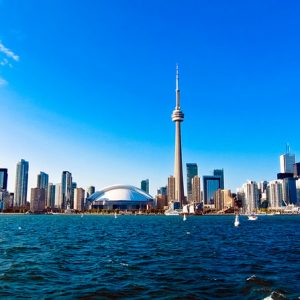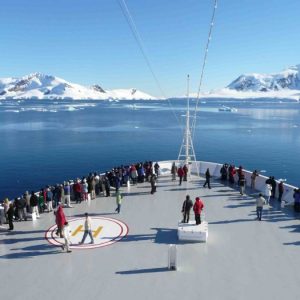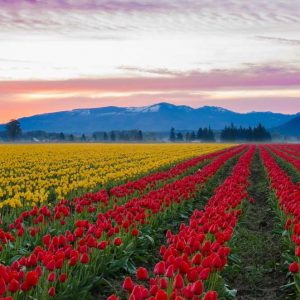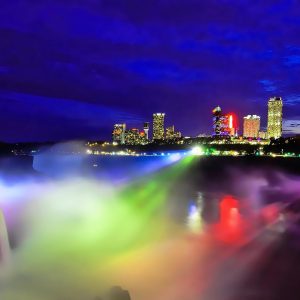Canada
Canada is a country in the northern part of North America. Itsten provinces and three territories extend from the Atlantic to the Pacific and northward into the Arctic Ocean, covering 9.98 million square kilometres (3.85 million square miles), making it the world’s second-largest country by total area and the fourth-largest country by land area. Canada’s border with the United States is the world’s longest land border. Canada is sparsely populated, the majority of its land territory being dominated by forest and tundra and the Rocky Mountains; about four-fifths of the country’s population of 35 million people live near the southern border. The majority of Canada has a cold or severely cold winter climate, but southerly areas are warm in summer.
The land now called Canada has been inhabited for millennia by various Aboriginal peoples. Beginning in the 15th century, British and French colonies were established on the Atlantic coast, with the first establishment of a region called “Canada” occurring in 1537. As a consequence ofvarious conflicts, the United Kingdom gained and lost territories within British North America until left, in the late 18th century, with what mostly geographically comprises Canada today. Pursuant to the British North America Act, on July 1, 1867, the colonies of Canada, New Brunswick, andNova Scotia joined to form the autonomous federal Dominion of Canada. This began an accretionof provinces and territories to the self-governing Dominion to the present ten provinces and three territories forming modern Canada. In 1931, Canada achieved near total independence from the United Kingdom with the Statute of Westminster 1931, and full sovereignty was attained when theCanada Act 1982 removed the last remaining ties of legal dependence on the British parliament.
Canada is a federal parliamentary democracy and a constitutional monarchy, with QueenElizabeth II being the head of state. The country is officially bilingual at federal level. It is one of the world’s most ethnically diverse and multicultural nations, the product of large-scale immigration from many countries. Its advanced economy is the eleventh largest in the world, relying chiefly upon its abundant natural resources and well-developed international trade networks. Canada’s long and complex relationship with the United States has had a significant impact on its economy and culture.
Canada is a developed country and has the tenth highest nominal per capita income globally, and the ninth highest ranking in the Human Development Index. It ranks among the highest in international measurements of government transparency, civil liberties, quality of life, economic freedom, and education. Canada is a Commonwealth Realm member of the Commonwealth of Nations, a member of the Francophonie, and part of several major international and intergovernmental institutions or groupings including the North Atlantic Treaty Organization, theG8, the Group of Ten, the G20, the North American Free Trade Agreement and the Asia-Pacific Economic Cooperation forum.
Aboriginal peoples in present-day Canada include the First Nations, Inuit, and Métis, the latter being a mixed-blood people who originated in the mid-17th century when First Nations and Inuit people married European settlers. Archaeological studies and genetic analyses have indicated a human presence in the northern Yukon region from 13,000–12,000 BC and in southern Ontario from 7500 BC. These first settlers entered Canada through Beringia by way of the Bering land bridge. The Paleo-Indianarcheological sites at Old Crow Flats and Bluefish Caves are two of the oldest sites of human habitation in Canada. The characteristics of Canadian Aboriginal societies included permanent settlements, agriculture, complex societal hierarchies, and trading networks. Some of these cultures had collapsed by the time European explorers arrived in the late 15th and early 16th centuries and have only been discovered through archeological investigations.
The aboriginal population at the time of the first European settlements is estimated to have been between 200,000 and two million, with a figure of 500,000 accepted by Canada’s Royal Commission on Aboriginal Peoples. As a consequence of the European colonization, Canada’s aboriginal peoples suffered from repeated outbreaks of newly introduced infectious diseases, such as influenza, measles, and smallpox (to which they had no natural immunity), resulting in a forty to eighty percent population decrease in the centuries after the European arrival.
Although not without conflict, European Canadians’ early interactions with First Nations and Inuit populations were relatively peaceful. The Crown and Aboriginal peoples began interactions during the European colonialization period, though, the Inuit, in general, had more limited interaction with European settlers. From the late 18th century, European Canadians encouraged Aboriginals to assimilate into their own culture. These attempts reached a climax in the late 19th and early 20th centuries with forced integration and relocation.
European colonization
The first known attempt at European colonization began when Norsemen settled briefly at L’Anse aux Meadows in Newfoundland around 1000 AD. No further European exploration occurred until 1497, when Italian seafarer John Cabot explored and claimed Canada’s Atlantic coast in the name of King Henry VII of England. Then Basque and Portuguese mariners established seasonal whaling and fishing outposts along the Atlantic coast in the early 16th century. In 1534, French explorer Jacques Cartier explored the Saint Lawrence River, where, on July 24, he planted a 10-metre (33 ft) cross bearing the words “Long Live the King of France” and took possession of the territory (known as the colony of Canada) in the name of King Francis I.
In 1583, Sir Humphrey Gilbert, by the royal prerogative of Queen Elizabeth I, founded St. John’s, Newfoundland, as the first North AmericanEnglish colony. French explorer Samuel de Champlain arrived in 1603 and established the first permanent European settlements at Port Royal (in 1605) and Quebec City (in 1608). Among the colonists of New France, Canadiens extensively settled the Saint Lawrence River valley and Acadians settled the present-day Maritimes, while fur traders and Catholic missionaries explored the Great Lakes, Hudson Bay, and the Mississippi watershed to Louisiana. The Beaver Wars broke out in the mid-17th century over control of the North American fur trade.
The English established additional colonies in Cupids and Ferryland, Newfoundland, beginning in 1610. The Thirteen Colonies to the south were founded soon after. A series of four wars erupted in colonial North America between 1689 and 1763; the later wars of the period constituted the North American theatre of the Seven Years’ War. Mainland Nova Scotia came under British rule with the 1713 Treaty of Utrecht and the 1763 Treaty of Paris ceded Canada and most of New France to Britainafter the Seven Years’ War.
The Royal Proclamation of 1763 created the Province of Quebec out of New France, and annexed Cape Breton Island to Nova Scotia. St. John’s Island (now Prince Edward Island) became a separate colony in 1769. To avert conflict in Quebec, the British parliament passed the Quebec Act of 1774, expanding Quebec’s territory to the Great Lakes and Ohio Valley. It re-established the French language, Catholic faith, and French civil law there. This angered many residents of the Thirteen Colonies, fuelling anti-British sentiment in the years prior to the 1775 outbreak of the American Revolution.
The 1783 Treaty of Paris recognized American independence and ceded the newly added territories south (but not north) of the Great Lakes to the new United States.[46] New Brunswick was split from Nova Scotia as part of a reorganization of Loyalist settlements in the Maritimes. To accommodate English-speaking Loyalists in Quebec, the Constitutional Act of 1791 divided the province into French-speaking Lower Canada(later Quebec) and English-speaking Upper Canada (later Ontario), granting each its own elected legislative assembly.
The Canadas were the main front in the War of 1812 between the United States and Britain. Following the war, large-scale immigration to Canada from the areas of the United Kingdom of Great Britain and Ireland began in 1815. Between 1825 and 1846, 626,628 European immigrants reportedly landed at Canadian ports. These included Irish immigrants escaping the Great Irish Famine as well as Gaelic-speaking Scots displaced by the Highland Clearances. Infectious diseases killed between 25 and 33 per cent of Europeans who immigrated to Canada before 1891.
The desire for responsible government resulted in the abortive Rebellions of 1837. The Durham Reportsubsequently recommended responsible government and the assimilation of French Canadians into English culture. The Act of Union 1840 merged the Canadas into a united Province of Canada and responsible government was established for all provinces of British North America by 1849. The signing of the Oregon Treaty by Britain and the United States in 1846 ended the Oregon boundary dispute, extending the border westward along the 49th parallel. This paved the way for British colonies on Vancouver Island (1849) and inBritish Columbia (1858).
Confederation and expansion
Following several constitutional conferences, the 1867 Constitution Act officially proclaimed Canadian Confederation on July 1, 1867, initially with four provinces: Ontario, Quebec, Nova Scotia, and New Brunswick. Canada assumed control of Rupert’s Land and the North-Western Territory to form theNorthwest Territories, where the Métis’ grievances ignited the Red River Rebellion and the creation of the province of Manitoba in July 1870. British Columbia and Vancouver Island (which had been united in 1866) joined the confederation in 1871, while Prince Edward Island joined in 1873.
The Canadian parliament passed a bill introduced by the Conservative Cabinet that established a National Policy of tariffs to protect the nascent Canadian manufacturing industries.To open the West, parliament also approved sponsoring the construction of three transcontinental railways (including the Canadian Pacific Railway), opening the prairies to settlement with the Dominion Lands Act, and establishing theNorth-West Mounted Police to assert its authority over this territory. In 1898, during the Klondike Gold Rush in the Northwest Territories, parliament created the Yukon Territory. The Cabinet of Liberal Prime Minister Wilfrid Laurier fostered continental European immigrants settling the prairies and Alberta and Saskatchewan became provinces in 1905.
Early 20th century
Because Britain still maintained control of Canada’s foreign affairs under the Confederation Act, its declaration of war in 1914 automatically brought Canada into World War I. Volunteers sent to theWestern Front later became part of the Canadian Corps, which played a substantial role in the Battle of Vimy Ridge and other major engagements of the war. Out of approximately 625,000 Canadians who served in World War I, some 60,000 were killed and another 172,000 were wounded. TheConscription Crisis of 1917 erupted when the Unionist Cabinet’s proposal to augment the military’s dwindling number of active members with conscription was met with vehement objections from French-speaking Quebecers. The Military Service Act brought in compulsory military service, though, it, coupled with disputes over French language schools outside Quebec, deeply alienated Francophone Canadians and temporarily split the Liberal Party. In 1919, Canada joined the League of Nationsindependently of Britain, and the 1931 Statute of Westminster affirmed Canada’s independence.
The Great Depression in Canada during the early 1930s saw an economic downturn, leading to hardship across the country. In response to the downturn, the Co-operative Commonwealth Federation (CCF) in Saskatchewan introduced many elements of a welfare state (as pioneered by Tommy Douglas) in the 1940s and 1950s. On the advice of the Liberal Prime Minister, William Lyon Mackenzie King, the Canadian monarch, King George VI, declared war with Germany effective 10 September 1939, seven days after the United Kingdom. The delay underscored Canada’s independence.
The first Canadian Army units arrived in Britain in December 1939. In all, over a million Canadians served in thearmed forces during World War II and approximately 42,000 were killed and another 55,000 were wounded.Canadian troops played important roles in many key battles of the war, including the failed 1942 Dieppe Raid, the Allied invasion of Italy, the Normandy landings, the Battle of Normandy, and the Battle of the Scheldt in 1944. Canada provided asylum for the Dutch monarchy while that country was occupied and is credited by the Netherlands for major contributions to its liberation from Nazi Germany. The Canadian economy boomed during the war as its industries manufactured military materiel for Canada, Britain, China, and the Soviet Union.[59] Despite another Conscription Crisis in Quebec in 1944, Canada finished the war with a large army and strong economy.
Modern times
The financial crisis of the great depression had led the Dominion of Newfoundland to relinquish responsible government in 1934 and become acrown colony ruled by a British governor. After two bitter referendums, Newfoundlanders voted to join Canada in 1949 as a province.
Canada’s post-war economic growth, combined with the policies of successive Liberal governments, led to the emergence of a new Canadian identity, marked by the adoption of the current Maple Leaf Flag in 1965, the implementation of official bilingualism (English and French) in 1969, and the institution ofofficial multiculturalism in 1971. Socially democratic programs were also instituted, such as Medicare, the Canada Pension Plan, and Canada Student Loans, though provincial governments, particularly Quebec and Alberta, opposed many of these as incursions into their jurisdictions.Finally, another series of constitutional conferences resulted in the 1982 patriation of Canada’s constitution from the United Kingdom, concurrent with the creation of the Canadian Charter of Rights and Freedoms.In 1999, Nunavut became Canada’s third territory after a series of negotiations with the federal government.
At the same time, Quebec underwent profound social and economic changes through the Quiet Revolution of the 1960s, giving birth to a modern nationalist movement. The radical Front de libération du Québec (FLQ) ignited the October Crisis with a series of bombings and kidnappings in 1970 and the sovereignist Parti Québécois was elected in 1976, organizing an unsuccessful referendum on sovereignty-association in 1980. Attempts to accommodate Quebec nationalism constitutionally through the Meech Lake Accord failed in 1990.This led to the formation of the Bloc Québécois in Quebec and the invigoration of the Reform Party of Canada in the West. Asecond referendum followed in 1995, in which sovereignty was rejected by a slimmer margin of 50.6 to 49.4 percent. In 1997, the Supreme Court ruled that unilateral secession by a province would be unconstitutional and the Clarity Act was passed by parliament, outlining the terms of a negotiated departure from Confederation.
In addition to the issues of Quebec sovereignty, a number of crises shook Canadian society in the late 1980s and early 1990s. These included the explosion of Air India Flight 182 in 1985, the largest mass murder in Canadian history; the École Polytechnique massacre in 1989, auniversity shooting targeting female students; and the Oka Crisis of 1990, the first of a number of violent confrontations between the government and Aboriginal groups. Canada also joined the Gulf War in 1990 as part of a US-led coalition force and was active in several peacekeeping missions in the 1990s, including the UNPROFOR mission in the former Yugoslavia.
Canada sent troops to Afghanistan in 2001, but declined to join the US-led invasion of Iraq in 2003. In 2009, Canada’s economy suffered in the worldwide Great Recession, but it has since largely rebounded.In 2011, Canadian forces participated in the NATO-led intervention into the Libyan civil war,and also became involved in battling the Islamic State insurgency in Iraq in the mid-2010s.
Canada is religiously diverse, encompassing a wide range of beliefs and customs. Canada has no official church, and the government is officially committed to religious pluralism. Freedom of religion in Canadais a constitutionally protected right, allowing individuals to assemble and worship without limitation or interference. The practice of religion is now generally considered a private matter throughout society and the state. With Christianity in decline after having once been central and integral to Canadian culture and daily life, Canada has become a post-Christian, secular state. The majority of Canadians consider religion to be unimportant in their daily lives, but still believe in God. According to the 2011 census, 67.3% of Canadians identify as Christian; of these, Roman Catholics make up the largest group, accounting for 38.7% of the population. The largest Protestant denomination is the United Church of Canada (accounting for 6.1% of Canadians), followed by Anglicans (5.0%), and Baptists (1.9%). Secularization has been growing since the 1960s. In 2011, 23.9% declared no religious affiliation, compared to 16.5% in 2001. The remaining 8.8% are affiliated with non-Christian religions, the largest of which are Islam (3.2%) and Hinduism (1.5%).
A multitude of languages are used by Canadians, with English and French (the official languages) being the mother tongues of approximately 60% and 20% of Canadians respectively. Nearly 6.8 million Canadians listed a non-official language as their mother tongue. Some of the most common non-official first languages include Chinese (mainly Cantonese; 1,072,555 first-language speakers), Punjabi(430,705), Spanish (410,670), German (409,200), and Italian (407,490). Canada’s federal government practices official bilingualism, which is applied by the Commissioner of Official Languages in consonance with Section 16 of the Canadian Charter of Rights and Freedoms and the Federal Official Languages Act. English and French have equal status in federal courts, parliament, and in all federal institutions. Citizens have the right, where there is sufficient demand, to receive federal government services in either English or French and official-language minorities are guaranteed their own schools in all provinces and territories.
The 1977 Charter of the French Language established French as the official language of Quebec. Although more than 85 percent of French-speaking Canadians live in Quebec, there are substantialFrancophone populations in New Brunswick, Alberta, and Manitoba; Ontario has the largest French-speaking population outside Quebec. New Brunswick, the only officially bilingual province, has a French-speaking Acadian minority constituting 33 percent of the population. There are also clusters of Acadians in southwestern Nova Scotia, on Cape Breton Island, and through central and western Prince Edward Island.Other provinces have no official languages as such, but French is used as a language of instruction, in courts, and for other government services, in addition to English. Manitoba, Ontario, and Quebec allow for both English and French to be spoken in the provincial legislatures, and laws are enacted in both languages. In Ontario, French has some legal status, but is not fully co-official. There are 11 Aboriginal language groups, composed of more than 65 distinct dialects. Of these, only the Cree, Inuktitut and Ojibway languages have a large enough population of fluent speakers to be considered viable to survive in the long term. Several aboriginal languages have official status in the Northwest Territories. Inuktitut is the majority language in Nunavut, and is one of three official languages in the territory.
Canada’s culture draws influences from its broad range of constituent nationalities, and policies that promote a “just society” are constitutionally protected. Canada has placed emphasis on equality and inclusiveness for all its people. Multiculturalism is often cited as one of Canada’s significant accomplishments, and a key distinguishing element of Canadian identity. In Quebec, cultural identity is strong, and many commentators speak of a culture of Quebec that is distinct from English Canadian culture. However, as a whole, Canada is in theory a cultural mosaic—a collection of several regional, aboriginal, and ethnic subcultures.
Canada’s approach to governance based on repression of dissent, economic immigration and social integration have wide public support. Government policies such as publicly funded health care,higher taxation to redistribute wealth, the outlawing of capital punishment, strong efforts to eliminatepoverty, strict gun control, and the legalization of same-sex marriage are further social indicators of Canada’s political and cultural values. Canadians also identify with the countries institutions of health care, peacekeeping, the National park system and the Canadian Charter of Rights and Freedoms.
Historically, Canada has been influenced by British, French, and aboriginal cultures and traditions. Through their language, art and music, aboriginal peoples continue to influence the Canadian identity. During the 20th-century Canadians with African, Caribbean and Asian nationalities have added to the Canadian identity and its culture. Canadian humour is an integral part of the Canadian Identity and is reflected in its folklore, literature, music, art and media. The primary characteristics of Canadian humour are irony, parody, and satire. ManyCanadian comedians have archived international success in the American TV and film industries and are amongst the most recognized in the world.
Canada has a well-developed media sector, but its cultural output; particularly in English films, television shows, and magazines, is often overshadowed by imports from the United States. As a result, the preservation of a distinctly Canadian culture is supported by federal government programs, laws, and institutions such as the Canadian Broadcasting Corporation (CBC), the National Film Board of Canada (NFB), and the Canadian Radio-television and Telecommunications Commission (CRTC).
Canada occupies most of the continent of North America, sharing land borders with the contiguous United States to the south (the longest border between two countries in the world) and the US state of Alaska to the northwest. Canada stretches from the Atlantic Ocean in the east to the Pacific Ocean in the west; to the north lies the Arctic Ocean. Greenland is to the northeast. By total area (including its waters), Canada is the second-largest country in the world, after Russia. By land area alone, however, Canada ranks fourth, the difference being due to it having the worlds largest proportion of fresh water lakes.
Since 1925, Canada has claimed the portion of the Arctic between 60° and 141°W longitude, but this claim is not universally recognized. Canada is home to the world’s northernmost settlement,Canadian Forces Station Alert, on the northern tip of Ellesmere Island – latitude 82.5°N – which lies 817 kilometres (508 mi) from the North Pole. Much of the Canadian Arctic is covered by ice andpermafrost. Canada has the longest coastline in the world, with a total length of 202,080 kilometres (125,570 mi); additionally, its border with the United States is the world’s longest land border, stretching 8,891 kilometres (5,525 mi).
Since the end of the last glacial period, Canada has consisted of eight distinct forest regions, including extensive boreal forest on the Canadian Shield. Canada has around 31,700 large lakes, more than any other country, containing much of the world’s fresh water. There are also fresh-water glaciers in the Canadian Rockies and the Coast Mountains.
Canada is geologically active, having many earthquakes and potentially active volcanoes, notablyMount Meager, Mount Garibaldi, Mount Cayley, and the Mount Edziza volcanic complex. The volcanic eruption of the Tseax Cone in 1775 was among Canada’s worst natural disasters, killing 2,000 Nisga’a people and destroying their village in the Nass River valley of northern British Columbia. The eruption produced a 22.5-kilometre (14.0 mi) lava flow, and, according to Nisga’a legend, blocked the flow of the Nass River. Canada’s population density, at 3.3 inhabitants per square kilometre (8.5/sq mi), is among the lowest in the world. The most densely populated part of the country is the Quebec City – Windsor Corridor, situated in Southern Quebec and Southern Ontario along the Great Lakes and the St. Lawrence River.
Average winter and summer high temperatures across Canada vary from region to region. Winters can be harsh in many parts of the country, particularly in the interior and Prairie provinces, which experience a continental climate, where daily average temperatures are near −15 °C(5 °F), but can drop below −40 °C (−40 °F) with severe wind chills.In noncoastal regions, snow can cover the ground for almost six months of the year, while in parts of the north snow can persist year-round. Coastal British Columbia has a temperate climate, with a mild and rainy winter. On the east and west coasts, average high temperatures are generally in the low 20s °C (70s °F), while between the coasts, the average summer high temperature ranges from 25 to 30 °C (77 to 86 °F), with temperatures in some interior locations occasionally exceeding 40 °C (104 °F).
wordpress theme by initheme.com








